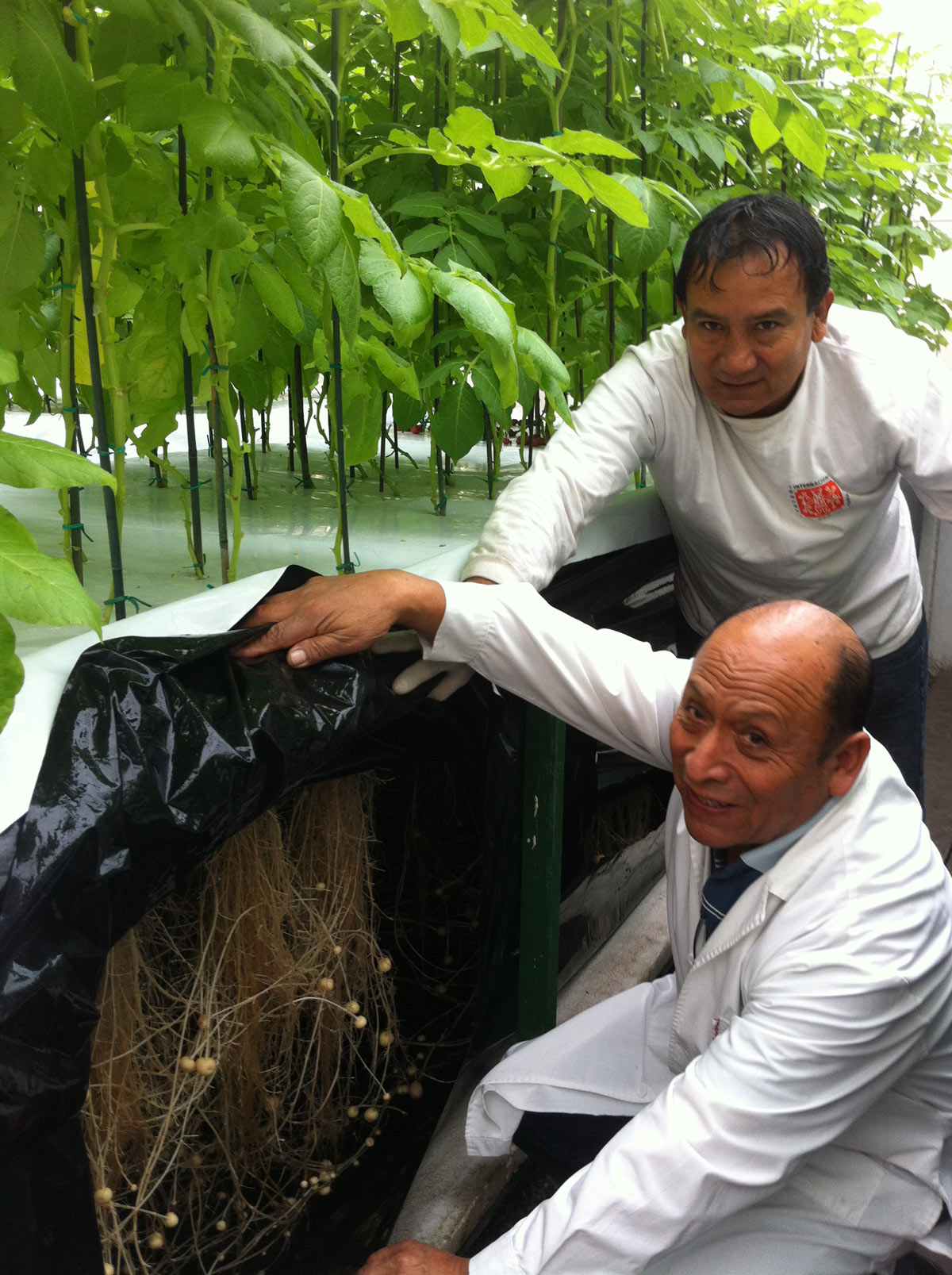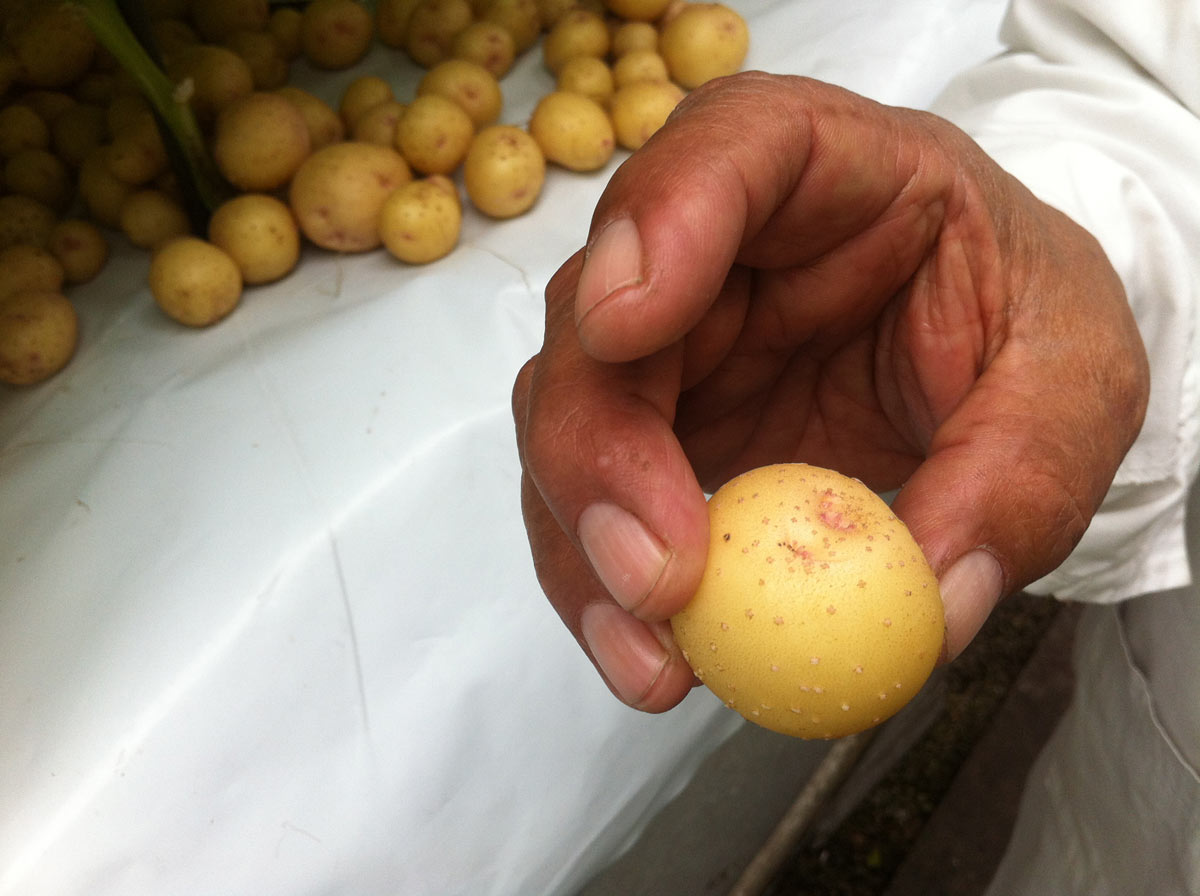One of the intrinsic problems facing rural potato farmers in developing countries is access to quality seed for an increased and healthier harvest. Cleaner quality seeds however, are expensive and in many areas of Africa, Asia, and Latin America, accessing these seeds can be very difficult for poor farmers. One of the goals of the International Potato Center (CIP) is to find solutions for poor farmers, helping them avoid high production costs, increase sustainability, and improve their levels of livelihood. To this end, over the past seven years, CIP has dedicated time and research into developing aeroponic technology which is a soilless method for producing pre basic potato seed with higher yields (up to 10-times higher), more quickly, more sustainably, and with greater profits than conventional methods.
CIP’s aeroponic program began when CIP Virologist, Carlos Chuiquillanqui returned from a visit to North Korea in 2006 where he witnessed aeroponic technology being applied to tubers. He began to replicate and improve upon what he saw and today he is recognized as a leading global expert in Potato Aeroponics.

CIP Virologist and Aeroponic specialist, Carlos Chuquillanqui, in a CIP aeroponic greenhouse
At CIP, scientists such as Chuquillanqui use aeroponic technology to produce pre basic potato seed with a soilless method where they pump a solution of nutrients and water into large boxes as a mist where the root systems of potato plants hang and produce tubers. Aeroponics exploits the vertical space of a greenhouse and is able to optimize the development of roots, tubers, and foliage through the provision of these nutrient solutions. “While more expensive to set up, the long term economic benefits of aeroponic systems are pronounced, especially as the average plant produces upwards of ten times as many tubers as the plants grown using the conventional method,” explains Carlos Chuquillanqui.

Chuquillanqui demonstrates the soilless technology used to grow potato seed
Aeroponics in general is a relatively new technique and its implementation in CIP has seen potato seed production increase dramatically. Producers can recover initial investments quickly owing to high levels of profitability. However, the system also has its drawbacks. An aeroponic system is energy dependent, its personnel require high levels of technical training, materials may not be readily available in rural areas, and any root pathogens will spread rapidly throughout the root systems of aeroponic tuber plants. Nevertheless, these disadvantages may not detract from the overall environmental, social, and economic benefits of producing potato seed using an aeroponic system over conventional methods.
The conventional method of producing pre basic potato seed is to multiply clean seed in vitro in a greenhouse using sterile substrates and a mixture of various components. Until recently, seed producers utilizing the conventional method used methyl bromide to disinfect and clean the soil. However, scientists discovered that the chemical had a significant effect on earth’s ozone layer. As a result, International law prohibits the use of the methyl bromide under the Montreal Protocol. Seed producers now use other chemicals in the widespread conventional seed producing practice, and while less harmful, tests are still required to assess the environmental sustainability of the method.
Recent research conducted at CIP as part of a thesis written by Magali Garcia from the University of La Molina, analyzes the sustainability of greenhouse production for both aeroponic and conventional systems in order to identify their social, economic and environmental sustainability indicators, and to evaluate their levels of sustainability.
Garcia carried out her research in two phases. The first was a production phase in a greenhouse at CIP where she evaluated the two production methods – aeroponics using rooted cuttings and the conventional method using rooted cuttings in soil beds with substrates. Two relatively new CIP varieties were used (Serranita and Chucmarina) in a randomized design with four repetitions. The second phase of her research included a study to determine the sustainability of production systems through interviews conducted with producers using one or both systems. Garcia then used sustainability indicators to gauge the feasibility of each production system.
Garcia’s findings show that while the lowest production cost per square meter is obtained using the conventional system, the highest total income and profitability is obtained using the aeroponic system. Aeroponic systems produced up to 324 tubers/m2, while the conventional system produced lows of 54 tuber/m2. Garcia then developed sustainability indicators (proposed by Sarandón and Flores – 2009) for both systems in order to gauge their relative impacts in terms of social, economic, and environmental sustainability. The aeroponic system weighed in at 2.74 above the conventional system of 2.56.

The aeroponic system produces quality mini tubers for potato seed with little if any aberrations or defects
The results are relatively close, and Garcia maintains that both systems have their strengths and weaknesses. Her findings would suggest that companies or institutions with high technical capabilities employ aeroponic technologies in order to maximize production and profits in an environmentally sustainable manner. However, while performance is high for aeroponics, so is the risk of total loss, and this makes the conventional method more attractive for small-scale producers. Ultimately, Garcia claims that, “The ideal choice is to combine both technologies which are complimentary. This would allow for much higher production levels and maximized performances, while caring for the environment and reducing the risks of loss.”
Ultimately, the choice is up to the producer. However, studies such as this make it clear that there is much room for improvement and the need to supply poor farmers with quality seed continues. Meanwhile, Carlos Chuquillanqui advocates that advances are continually being made to aeroponic technology, and that, “The adoption of such systems in the future will greatly benefit both potato and sweetpotato farmers around the world.”
To see the Aeroponics Photo Gallery in full screen, click here
